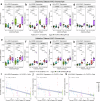Spatial transcriptomic profiling of the human fallopian tube epithelium reveals region-specific gene expression patterns
- PMID: 40158048
- PMCID: PMC11954873
- DOI: 10.1038/s42003-025-07871-w
Spatial transcriptomic profiling of the human fallopian tube epithelium reveals region-specific gene expression patterns
Abstract
The fallopian tube (FT) plays a crucial role in fertility, gynecological health, and high-grade serous ovarian cancer (HGSOC) development. Despite its importance, the spatial transcriptome of the FT's distinct anatomical regions (fimbria, infundibulum, ampulla, and isthmus) remains underexplored. Using the GeoMx Digital Spatial Profiler (DSP) and a targeted ~1800 gene panel, we analyze premenopausal FT epithelium, identifying region-specific gene expression patterns. Our analysis reveals upregulation of mature ciliated cell markers (FOXJ1, MLF1, SPA17, and CTSS) approaching the fimbria, elevated ROS and apoptosis-related transcripts (TXNIP, PRDX5, BAD, GAS1) in the distal FT, and a switch in cell-cell adhesion transcripts (CDH1, CDH3) along the distal-to-proximal axis. We also provide evidence that MHC-II transcripts in the FT are differentially regulated throughout the menstrual cycle, with lower expression in follicular phase. These results suggest spatially regulated expression of FT transcripts with implications for fertilization and early neoplastic changes contributing to HGSOC.
© 2025. The Author(s).
Conflict of interest statement
Competing interests: A.K.G. is a co-founder of Sinochips Diagnostics, serves as a scientific advisory board member to Biovica, Clara Biotech, and Sinochips Diagnostics, and receives research funding from Predicine and VITRAC Therapeutics. The other authors report no conflict of interest.
Figures






References
-
- Miller, J. H., Weinberg, R. K., Canino, N. L., Klein, N. A. & Soules, M. R. The pattern of infertility diagnoses in women of advanced reproductive age. Am. J. Obstet. Gynecol.181, 952–957 (1999). - PubMed
-
- Ferlay, J. et al. Cancer incidence and mortality worldwide: Sources, methods and major patterns in GLOBOCAN 2012. Int. J. Cancer136, E359–E386 (2015). - PubMed
-
- Medeiros, F. et al. The Tubal Fimbria Is a Preferred Site for Early Adenocarcinoma in Women With Familial Ovarian Cancer Syndrome. Am. J. Surgical Pathol.30, 230–236 (2006). - PubMed
-
- Lee, Y. et al. A candidate precursor to serous carcinoma that originates in the distal fallopian tube. J. Pathol.211, 26–35 (2007). - PubMed
MeSH terms
Grants and funding
LinkOut - more resources
Full Text Sources
Research Materials
Miscellaneous

